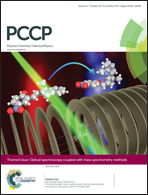Ultrafast charge separation and charge stabilization in axially linked ‘tetrathiafulvalene–aluminum(iii) porphyrin–gold(iii) porphyrin’ reaction center mimics†
Abstract
The axial bonding ability of aluminum(III) porphyrin (AlPor) has been exploited to synthesize the vertically linked dyad ‘aluminum(III) porphyrin–gold(III) porphyrin’ (AlPor-Ph–AuPor+) and the two corresponding self-assembled triads ‘tetrathiafulvalene–aluminum(III) porphyrin–gold(III) porphyrin’ (TTF-py→AlPor-Ph–AuPor+ and TTF-Ph-py→AlPor-Ph–AuPor+). The unique topology of these triads provides an excellent opportunity to investigate the sequential electron transfer in the perpendicular direction to the AlPor plane where the AlPor acts as a photosensitizer and primary electron donor while the AuPor and TTF serve as an electron acceptor and donor, respectively. The ground state properties of the dyad and triad suggest that there are no direct intramolecular interactions between the oppositely disposed AuPor and TTF units of the triad. However, the NMR and UV-visible absorption studies of the dyad reveal intermolecular interactions in non-coordinating solvents due to the coordination of counterion PF6− to the Al center of AlPor. Steady-state and femtosecond transient absorption studies of the dyad show that the lowest excited singlet state of AlPor (1AlPor*) is strongly quenched by ultrafast electron transfer to AuPor+ with a time constant of 3.16 ps. The resulting charge separated state (AlPor+˙–AuPor˙) decays to ground state biexponentially with time constants of 27.26 and 2557 ps. Analogously, upon photo-excitation the triads also produce the same primary radical pair (AlPor+˙–AuPor˙). However, the formed radical pair is further involved in a rapid hole transfer from AlPor+˙ to TTF to form a stable final radical pair TTF+˙–AlPor–AuPor˙. The lifetime of the charge separated state exhibits an increase from 27.26 ps in AlPor-Ph–AuPor to 1393 ps in TTF-py→AlPor-Ph–AuPor+ and 1484 ps in TTF-Ph-py→AlPor-Ph–AuPor+. These results reveal successful charge stabilization in the self-assembled supramolecular reaction center mimics constructed via the axial linkage strategy.



 Please wait while we load your content...
Please wait while we load your content...